Halloween isn’t just about costumes and sweets. Samhain, as the festival is traditionally known, is a wonderful time for acknowledging the past and letting go before calling in your hopes and dreams for the future.
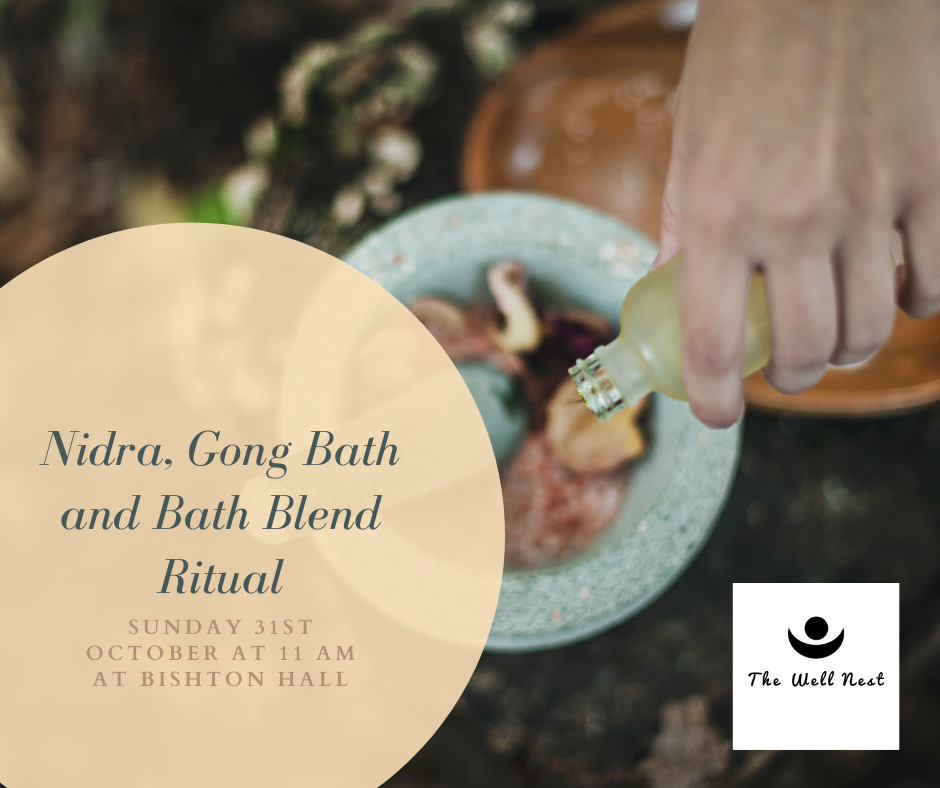
October’s unique workshop will bring together the best of the season and the energetic changes to give you a boost into the Autumn with a fresh outlook and high spirits. The workshops uses aromatherapy, sound waves and yogic sleep to help you relax deeply before calling your hopes into being.
Your body, mind and spirit all benefit from this practice of aroma, relaxation, meditation and sound therapy. It’s a complete package for renewal! This year, Samhain falls between the date at which Venus is closest to the earth (29th October) and a new moon (4th November) making it the perfect time to cleanse, release and turn our energy towards the new.
This workshop will be an opportunity to use ritual and relaxation to make the most of the spiritual and celestial energies available to make a new start. We will begin our workshop session by crafting a personal blend of bath salts, essential oils and natural ingredients to take away and use over the next 30 days to repeat our intentions for the future whilst practicing self-care. You will be encouraged to set intentions and affirmations for the future as you build your self care bath ritual blend.
We will then begin a yoga nidra session – deep relaxation bringing us to the cusp of sleep so that our consciousness becomes susceptible to creativity, intuition and release on a deeper level. This is a passive practice, so no physical postures are practiced – it is a guided visualisation and relaxation practice. Get comfortable under blankets and drift away.
We will then transition into a gong bath to let the sound waves wash over us, cleansing the mind and body and allowing us to start anew.
The focus of this workshop will be based around the energies available to us from the cosmos at this point in time:
Samhain/Halloween – a time of transition from the old to the new. A slowing down of one cycle and the beginning of another. Coming into a deep rest before calling our dreams and wishes into reality.
Venus – A focus on the heart chakra and self compassion. Looking deeply at our own happiness and how we gather and expend our personal resources. We will be able to utilise the divine feminine/shakti energy of the provider, nurturer and fierce protector to help manifest our goals
New moon – Heart chakra energy from the new moon helps us to align for a new beginning and cleanses us of whatever has just past or is no longer beneficial. This energy is a powerful force for helping us to let go.
Everybody will be able to create their own blends using salts, oils, plants, natural ingredients and the fruits of nature. You will take away the bath blend in a kilner jar to use at home several times as part of your own bathing, cleansing and intention setting ritual. You will also receive a free gift to take away.
Spaces are limited on this small, cozy workshop. All materials are provided…get yourself booked in!
Yoga Focus – What is Ashtanga Yoga?
If you’ve ever taken a vinyasa class with me, you will be familiar with a lot of the poses from the ashtanga lineage. Vinyasa yoga is essentially a free flowing version of ashtanga – anything goes. Ashtanga is itself quite the opposite; a set number of postures, in a set order…every time.
You may think this sounds a little restrictive and (gasp!) boring, but that is not the case with Ashtanga. There are so many poses and vinyasas (breath with movement) in and out of the poses, that boredom is the last thing on your mind. Lets take a closer look…

Historically speaking…
Ashtanga is a dynamic form of Hatha yoga that has its roots in the town of Mysore, south India. The ashtanga method is an ancient system of yoga that was taught by Vamana Rishi in the Yoga Kurunta. It is believed that the text was imparted to Sri T. Krishnamacharya in the early 1900’s by Guru Rama Mohan Brahmachari.
Ashtanga means ‘eight limbs’ as described by Patanjali (an Indian sage) in the Yoga Sutras (the Sutras are believed to have been written between the 2nd and 4th century CE). This text is the authority on the practice and true nature of yoga – the eight limbs must be practiced in order to realise our true potential, our true nature and transcend human suffering. Ashtanga embodies these eight limbs:
- Yamas (behavioural observances – things that we should do)
- Niyamas (behavioural restraints – things that we should not do)
- Asana (physical yoga postures)
- Pranayama (yogic breathwork to control the flow of our life force energy)
- Pratyahara (withdrawal of the senses)
- Dharana (concentration)
- Dhyana (meditation)
- Samadhi (liberation)
The practice that we know today as Ashtanga yoga was first developed, practiced and taught by the yogi Krishnamachrya in Mysore, India. A student of Krishnamacharya, Pattabhi Jois continued the work of sharing the ashtanga method throughout the world. Today the method is continued by Manju and Sharath Jois (son and grandson of Pattabhi respectively). Ashtanga yoga is therefore a lineage as well as a practice and encourages many dedicated, life-long practitioners throughout the world.
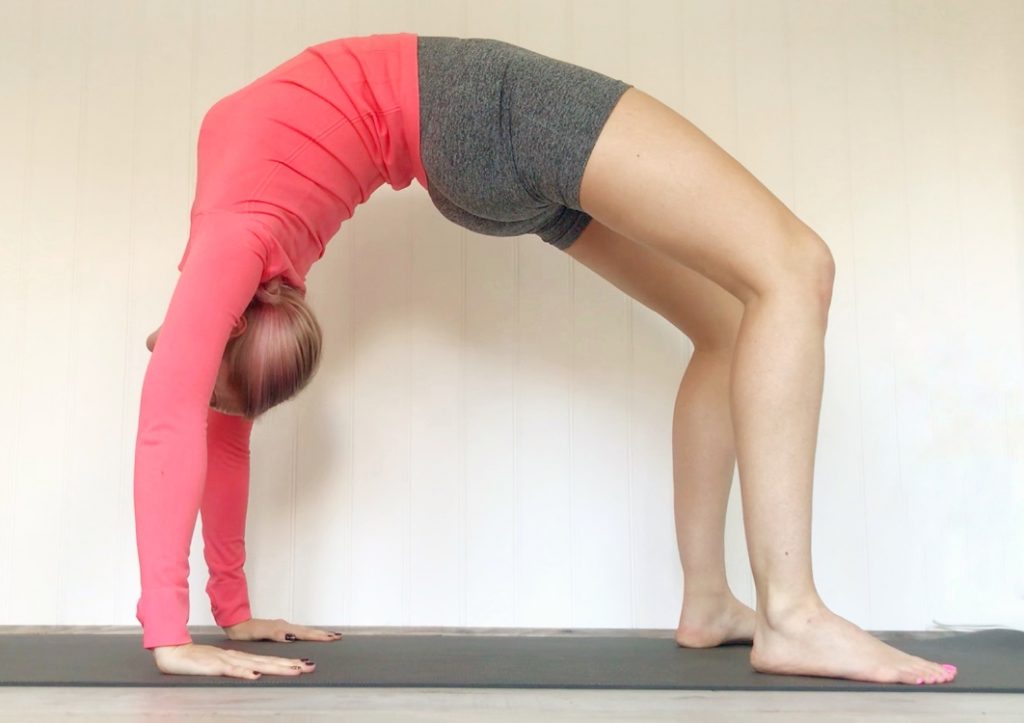
What to expect
Ashtanga yoga is taught in series’ of postures and each student of ashtanga practices the postures according to their own ability. Students are ‘given’ postures by the teacher and practice their sequence individually (although in classes with others) under the guidance of the teacher. Each student therefore is carrying out their individual practice, broadly the same as the other students and yet unique to them. More postures are added to the series as the student grows in strength and flexibility until completion of a series. The next series can then begin (phew!).
This individual approach to yoga (rather than being in a class where everybody is taught the same thing and follows the teacher through the class) is known as ‘Mysore style’ after the place it was originally taught by Krishnamachrya and Pattabhi Jois. Ashtanga can also be presented as a ‘led’ class in the style that we are familiar with, where everybody works through the poses at the same time guided by the teacher – this style is a great place to start your practice.
All students of ashtanga start by learning the postures of the Primary Series. This series is known as Yoga Chikitsa or yoga therapy. The aim is to loosen the body and free the practitioner from stiffness or weakness and allow them the freedom to practice fully. You will find hip opening, hamstring lengthening, spinal flexibility, strength and stamina in the Primary Series.

Is it for me?
Ashtanga yoga is a dynamic practice so you should be prepared to work hard. However, it isn’t yoga for the advanced only and it certainly isn’t reserved for the flexible. Ashtanga often has a reputation for rigidity, but the practice lends itself to variation and modification to suit the individual. Nobody starts an ashtanga practice able to ‘do’ all of the postures. There is work for everybody in this practice.
So what exactly will you find at an ashtanga class?
Structure – the Primary Series (where we all start) consists of sun salutations, fundamental asanas (postures), standing sequence, seated sequence, backbends and a closing sequence. You will learn to know what to expect, but no two days are the same for your body.
Sweat – the practice of ashtanga builds heat in the body. It can be strenuous and definitely raises the heart rate.
Breath-work – each movement in ashtanga is accompanied by the breath. We use the breath to move in and out of poses or hold poses for a breath count. This is the vinyasa – breath with movement.
Meditation – ashtanga, though a strong dynamic practice, becomes a moving meditation due to the structure, breath and counted nature of the vinyasas. You leave the mind behind and crowd out thoughts with the practice.
Accomplishment – The yoga journey is never about achieving postures but about moving beyond the ego to reside in peace; the true nature of the self. Due to the dynamic nature of ashtanga, you will also feel like you have achieved great things. Your body and mind will change with a consistent practice.
Ashtanga is a great place to advance your practice. If you’ve been a yogi for a few years and have felt the magic of yoga, the ashtanga method might be for you. Step outside the comfort zone, try new things and surprise yourself; find strength in backbends, find balance in headstand, find calm in deep twists.
Join me twice a month on Wednesday evenings to get to know the ashtanga method. Master the mind and the body and feel the endorphins flow!
Om shanti shanti shanti
Yoga Focus – What is Kundalini Yoga?
Often referred to as the ‘Yoga of Awareness’ or ‘Holistic Yoga’, Kundalini yoga is a practice fusing several ancient practices and principles to enable the practitioner to manage and manipulate the energetic flow in the body. Kundalini includes the practices of Bhakti yoga (devotion and mantra chanting) Raja yoga (meditation, mental and physical control) and Shakti yoga (the expression and control of energy or power).
A kundalini yoga class can leave you feeling like you’ve been to therapy, done a workout and felt the earth move – vibrationally speaking. Kundalini is a modality by which practitioners can deeply cleanse the nervous system, tune into their inner potential and release energetic blockages or imbalances to find a peaceful life and a balanced outlook. This isn’t just yoga to make the body feel better – this is yoga that can create shifts in every area of your life.

Historically speaking…
The exact date and emergence of kundalini tantra is unclear, but the practices of kundalini energy manipulation and philosophy are mentioned in the Upanishads (vedic yoga texts) dating back to 1000 BC. The term Kundalini means a spiritual energy or life force located at the base of the spine and often represented by a coiled snake. Practicing Kundalini yoga awakens the kundalini shakti (energy of universal creation) and allows it to rise up through the chakra system along the spine to the crown of the head. Each chakra is a wheel or hub of energy at a particular point in the spine where energy channels intersect. Through practicing asana (physical postures), pranayama (yogic breathing techniques) and mantra it is possible to direct the flow of energy through the chakras to have profound effect on the nervous system, the mind and the flow of life. If you’ve ever felt like a passenger in your own life, kundalini may be what you’re searching for.
The practice of kundlini yoga historically was part of tantric tradition. Tantra means secret mantra and as such, the practice was the preserve of the very few privileged gurus and selected students. The modern presentation of Kundalini yoga that we often see today is a blend of several traditions brought to the mainstream by Yogi Bhajan in the 1960’s. Practice involves the use of Kriyas – yoga ‘sets’ of asana, pranayama, meditation and the use of yogic muscle locks or bandhas to direct energy flow and prepare the nervous system, mind and body for the flow of kundalini awakening and rising through the chakra system.
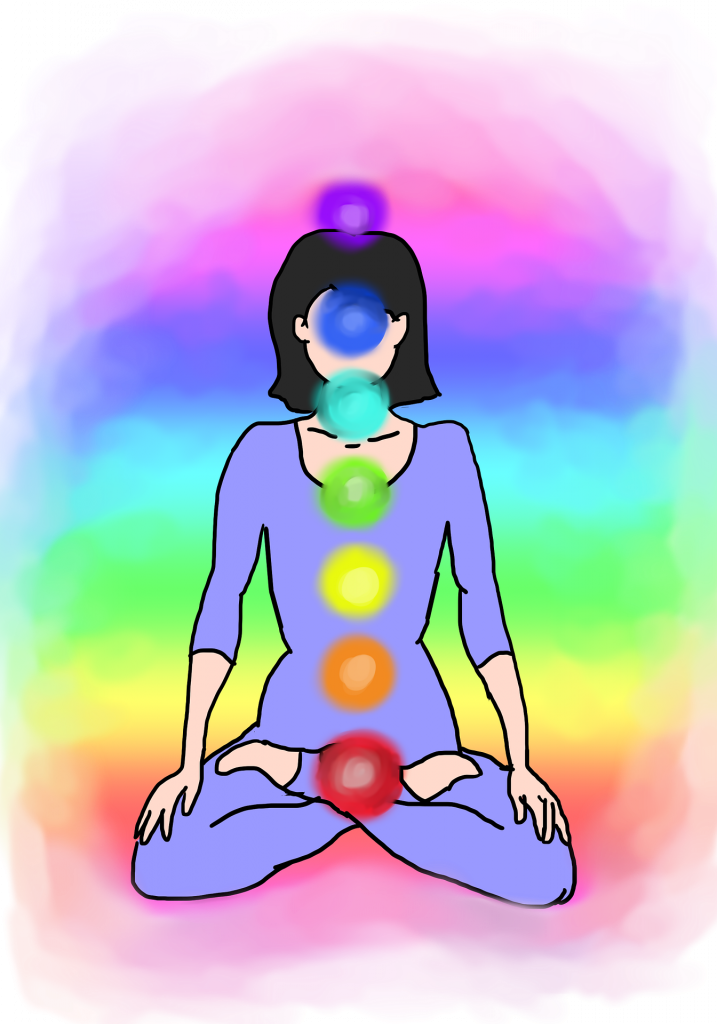
On wearing white
Traditionally teachers and students in kundalini class wear outfits of all white. The choice of white as the universal colour of practice is that colours have an effect on consciousness. Many holistic traditions refer to colours as being inseparably connected to energy points in the body. The chakra system is strongly identified with colours at points from the base of the spine to the crown. The Aura of each individual presents as colours depending on energy flow and interaction.
White is the colour that represents all 7 colours of the chakra system. By wearing white, we project the auric body further away from our physical form, making the energetic changes of our kundalini practice more profound. Wearing white contributes to the efficiency, profundity and progressive effect of our practice. Having said that…your practice is personal to you. If you feel more comfortable or you feel you have a deeper connection to another colour, you can wear whatever assists your practice.
Bowing to the truth within you
Each Kundalini session (following modern principles of Yogi Bhajan) starts with the process of tuning in. We do this by rubbing the palms together, pressing the hands together at the centre of the chest and engaging in the powerful mantra Ong Namo Guru Dev Namo three times. This is your recognition of the universal truth within; bowing to your own destiny.
What to expect
Kundalini yoga is weird – there I’ve said it. Now that’s out of the way, let’s look at what a typical class will involve. After tuning in, we start the Kriya – a set of postures (some of which may be familiar to you if you’ve practiced other forms of yoga), breathing techniques, muscle locks and mantra chanting (silently or out loud). Kundalini isn’t as dynamic as a vinyasa class – you won’t be getting up and down from your mat over and over – but it is still challenging. We use rapid repetition and controlled movements to channel energy. You will feel this as heat, emotional release, fatigue or muscle shakes (along with many other possible effects). It’s a full body, mind and spirit experience in each session. Classes will close with mantra, meditation or sound experiences.
Join me on Wednesday evenings twice a month to embark on the extraordinary journey that is kundalini yoga. Awaken your divine energy in 2021 and make this year the year you reclaim happiness.
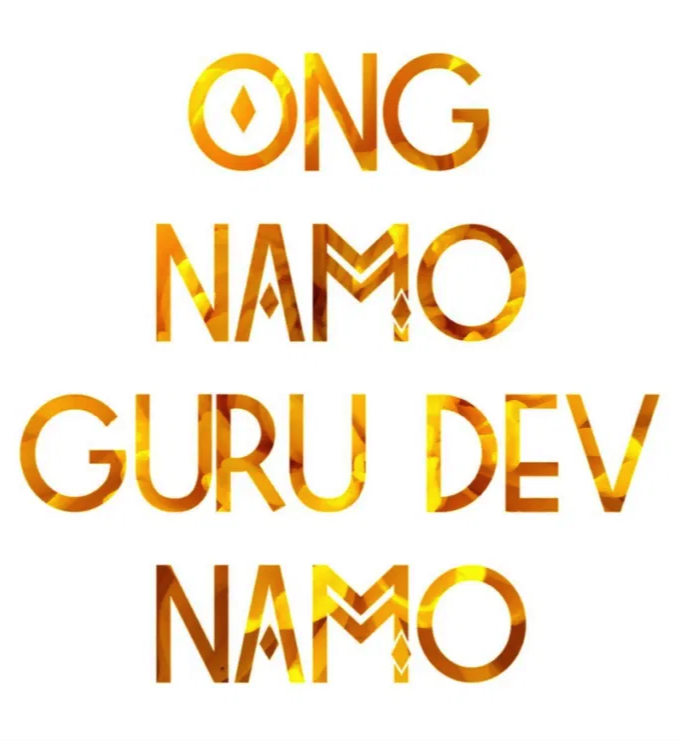
How Can Sound Therapy Help Me?
“Everything in life is vibration” – Albert Einstein
All things vibrate energetically due to their atomic or molecular structure. When we talk about our own vibration, we mean our overall state of being; relative to all that we interact with. It’s important that we recognise our own vibration and how that can be affected by all that we come into contact with – not just other people, but food, technology, weather, scent, buildings…it all matters to our vibration.
But why is vibration important?
Because we need to find balance to find wellness and wholeness. It sounds simple and yet in modern life it is so hard to find that balance and more so to keep it. Ancient cultures understood vibration and the importance of balancing energy to bring wellness to the individual and the community. Energetic balance is central to Shamanic principles of wellbeing, just as it is central to yogic philosophy, Traditional Chinese Medicine, aromatherapy, sound therapy…the list goes on.
Our ancestors knew that the individual could not find balance alone. But, as we move away from small community living to global society, what we actually find is we are billions of individuals that have lost a lot of our real and meaningful connection to each other. Competition and selfishness have caused us a great deal of physical and mental suffering.
If we recognise that balance is found in the principle of interconnectedness; that all things affect us just as we affect them; then we can regain our balance.

How do I know if I’m out of balance?
There are a number of signs that you may be feeling out of balance energetically:
- Feeling stuck and not sure of which decisions or directions to take in life
- Feeling of carrying a weight that often manifests as sadness or dissatisfaction
- Loss of motivation, even for the things that you enjoyed previously
- Stress and anxiety and feelings of overwhelm
- Periods of illness or inability to shake off illness
- Mood swings
- The ease and joy of life feel difficult to find
- Fatigue or lethargy
- Digestive discomfort
How can I find my Balance?
All things are connected, so all things affect your energetic balance. An upset in the balance of your energy can have great physical and mental effects, but sound therapy can help you to find the balance that has been lost by directing sound frequencies into the body and mind.
Sound Therapy
A profound way to access and heal energetic balance is through sound therapy. As you relax, traditional instruments that have been used for healing practices for centuries, are played on or near to your body. The frequencies of the sounds produced, effect and realign the frequencies and energetic balance of our bodies and minds.
The pure sounds enter the body and mind and can have a profound effect on emotional states, mental busyness and stress levels. Sound therapy can also treat physical ailments as the sound frequencies enter the body and resonate with water and fluid content in the cells. Rhythmic and repetitive sounds can also directly affect brainwave states to bring individuals into deeper states of relaxation, awareness and consciousness. The deeper states of relaxation activate the parasympathetic nervous system, turning down the body’s stress response and activating the release of hormones to bring the body back to balance chemically as well a energetically. Long-term or chronic illness such a fibromyalgia, chronic fatigue and osteoarthritis can also be alleviated through sound therapy as sound waves enter the body and encourage healing on a cellular level.
Sound therapy also has deep connection to Chakra theory. Each Chakra (energetic wheel) vibrates at a certain frequency and can be assisted back into balance and free movement through the use of sound therapy. Particular frequencies played on or near to the Chakras can have a profound rebalancing effect on overall wellbeing.
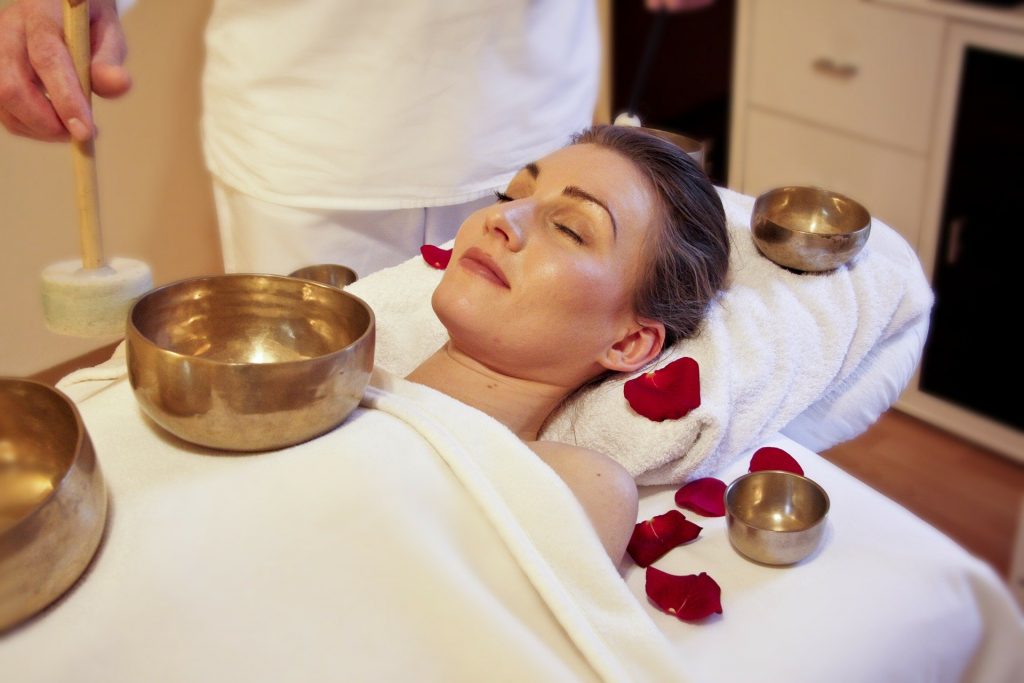
What’s involved in a therapy session?
Therapy sessions utilise tonal (singing bowls, bells, chimes etc) and rhythmic (drums, rattles etc) instruments as part of the therapeutic process. There may also be use of vocal toning and mantra to aid the process of relaxation and to create further resonant tones.
So many of our modern illness and imbalances are caused by stress and we often find ourselves tolerating the effects of stress for far longer than we should. Thinking, ‘things will get better’, ‘this will pass soon’, but often we struggle on for years.
Sound therapy isn’t just about listening to nice music and relaxing for an hour (although that does happen). Techniques of visualisation, reflection and grounding are built into the practice and afterwards to allow each client to gain a deeper insight into their own wellbeing and how practical steps to rebalance can be take in everyday life.
Following an initial consultation, you will relax on a therapy couch or on the floor (supported by blankets and pillows) and will be guided into relaxation before the therapy session begins. Based on your individual requirements and concerns, the therapist will play instruments directed at particular health concerns, imbalances or reactions that have manifested in the body or mind. Following the treatment you will be brought slowly out of the session with grounding techniques and self-reflection on your journey or experience during the treatment and in the following weeks.
How to book
Sessions are available throughout the week at The Well Nest Studio, very close to Stafford town centre. Please contact Hannah to check availability and make your booking. [email protected]
The first session you have will last 75 minutes to allow for the initial consultation and discussion of your requirements. Sessions can thereafter be booked for 60 or 45 minutes.
First session (75 minutes) £45
60 minute session £40
45 minute session £35
Small group sessions can also be provided at The Well Nest or at your home. please contact Hannah to make enquiries [email protected]
Mindfulness in sports
Mindfulness is the practice of applying awareness to the present moment through sense-based experience rather than thought. In other words, the ability to bring attention to what is happening right now, without imposing judgments on the quality or meaning of the experience. In practicing mindfulness, sportspeople are able to notice thoughts as passing mental events that don’t require action. The ability to observe in this way can lessen the reflex response to a situation and increase the ability to respond in a calmer more objective way.
We often remember the sporting outbursts (John McEnroe, Zinedine Zidane to name but a few) where players are overcome with rage, feelings of injustice or unfair treatment, or respond negatively to crowd interference. With athletes not only needing to consistently turn in their best performance, but also being role models for fans and aspiring young people, changing the way individuals react to thoughts is a growing area of focus in sports.
A Chosen Response
It is not just the one-off outbursts that sportspeople have to contend with; performance anxiety is a large factor whether you are a team player or individual athlete. So how can mindfulness help? Mindfulness can help individuals become aware of their thoughts, bodily sensations and environment. Through noticing as an observer what is happening in the present moment, we can choose to respond in a certain way instead of relying on the reflex, learned response that often isn’t the most helpful.

We can choose to notice the environmental conditions and make adjustments to our play. We can notice how certain scenarios cause tension in the body and we can choose to relax those parts of the body. Or, we can just notice as an observer and watch the feelings or thoughts arise and pass away – they are mental events that don’t necessarily need a reaction; especially where the thoughts are unhelpful or negative or likely to elicit a negative response. Sport can be a very stressful environment. Mindfulness can help individuals to let go of emotional responses and instead help them to act with more balance and wisdom; this could be the difference between winning and losing.
Improving Focus
Often in competitive sports (professional and amateur) it’s easy to ruminate on past mistakes or predict an outcome before the performance has even started. Mindfulness brings us back to the present moment – what is happening right now? By focusing only on what is happening in the moment, thoughts of predicted failure or learned reactions to past events start to lose their power. Our minds and bodies find a freedom to perform in the moment.
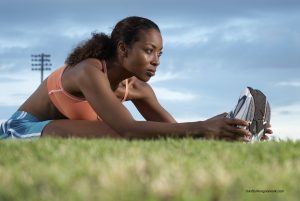
As an amateur competitive cyclist, I have felt and witnessed performance anxiety and the effects it can have on the enjoyment and outcome for individuals. It’s easy to slip into the mental cycle of berating yourself for not doing well, or having moments of self-doubt. Mindfulness might not stop these moments, but it will teach you how to observe them purely as mental events and not based on the reality of the moment. Bringing yourself back to the present and anchoring attention on your breath is a powerful practice to overcome attachment to negative thought patterns. Trying a simple breathing practice before an event can reset the mind and body to be able to focus productively on the current situation.
Positive Imagery
Mindfulness is a powerful method for creating space in the mind which can then be used to meditate on positive visualisations. Utilising the senses can affirm visualisations bringing them to life with vividness that can overcome anxiety and negative thought patterns. Creating a positive mental image of a shot, play, race or outcome can help increase confidence and focus making mindfulness an essential practice not only for success, but also for enjoyment.

Practicing mindfulness is mental training that helps refocus awareness so that attention can be redirected purposefully to help you perform to the best of your ability. As with all training, it is a process that requires commitment and repetition. Mindfulness begins with a sitting practice and deliberate times set aside for mindful enquiry. This then moves on to mindful movement and can become a whole of life practice that can be utilised on the court/pitch/field/track before, during and after performances.
The Well Nest could help your sports team to improve performance through the practice of Mindfulness. To learn more about mindfulness, tailor a mindfulness package for your club or team or to register for mindfulness courses in Staffordshire (suitable for everyone, not only athletes) take a look at the Mindfulness pages or contact [email protected]
Try something old; to find something new
Yoga classes are running all through the summer with the Well Nest – why not come along and give it a go!
Yoga is an ancient practice of mind and body that can help improve fitness and stamina as well as reducing anxiety and stress through calming the mind. A regular practice can change your life.
Classes available every week on Wednesdays and Thursdays at Colwich & Little Haywood Village Hall – no booking required, just turn up and practice. We have two friendly, mixed groups practicing regularly. Men and women are welcome and classes are suitable for all levels. Just £5 per class.
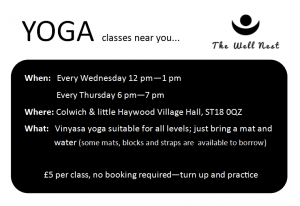
Spacious Back Bends with Ann-Marie Mainprize – Review
My visit to the Om Yoga Show this year provided the chance to try something completely different from the selection of classes available. I usually go for something demanding and full-on so I get a good workout as well as learn from new teachers. As I had managed to book onto two classes this year, I mixed it up with a class on backbends with Ann-Marie Mainprize of Amiyoga in Hull.
The class promised to ‘deepen backbends the Forrest yoga way’ through ‘connecting the core and releasing deep rooted postural tension’ – sounded excellent to me! As I’ve never tried Forrest yoga, that was an added bonus.
I know many people struggle with spinal flexibility and I often advocate core strength as a way of back-bending with confidence, so this sounded like a great way to improve my own knowledge and experience how other teachers focus a class on back-bending safely.
The class focused straight away on opening the front of the body as a way to improve flexibility and stability through the back of the body. We did a lot of strong abdominal work which although simple, was incredibly hard work on the deep core muscles. Lying flat on the back with legs straight in the air we were instructed to press the lower back into the mat and curl up the tail bone – the simple action of lifting in this way (with breath work and holds) was a huge workout for the core.
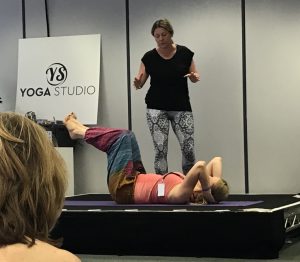
We went on to work dynamically through sun salutation B, some low lunges and lizard pose with a arrow foot stretch (pressing the top of the back foot down into the mat to apply a deeper stretch to the hip flexor) which was bliss but also agony for my tight hip flexors. We visited the ‘engaged glutes or relaxed glutes’ argument when in wheel and bridge – Ann-Marie was on the side of engaged glutes as it provides greater support for the lower back; something I agree with.
An interesting counterpose to all the back bending was to twist out rather than forward bend to reset the spine. Again there is a lot of discussion around this at the moment, but it was the first class I have been to where twist rather than forward bend was taught. I always found that bending the opposite way was counter-productive when deepening spinal flexion…but that forward fold always seems to really loosen the spine as well. The class with Ann-Marie was a real anatomy class – her knowledge was obvious but she made it accessible to all.
The one issue (which I found last year as well) was the poor quality mats provided for the workshops – almost on the edge of dangerous when in wheel as they were so slippery – this is a show issue not a workshop issue however.
I loved the class with Ann-Marie as it was obvious she was used to teaching all levels of students. Her approach was very instructive but helpful (she had three assistants providing hands-on assists throughout). This was a real workshop rather than a yoga class as poses were broken down with anatomy at the forefront. I would definitely recommend this class for yoga teachers.
The next day (and the day after) the muscles either side of my spine were definitely feeling the work that had been done in this class. The simple but effective core strengthening exercises feature regularly in my practice as well now. Definitely worth taking a class with Ann-Marie.
The Benefits of Yoga
We’ve all heard that yoga is good for body and mind but isn’t it all just a bit of gentle bending and stretching? What’s all the fuss about…?
The combination of breathing, relaxation, meditation, strength, balance and dynamic movement often found in yoga classes can bring a complete overhaul to our often chaotic lives and busy minds.
Some of the benefits of yoga are more obvious; it builds muscle strength, improves flexibility and stamina, it improves posture, strengthens bones and protects cartilage, it increases heart rate and blood flow and helps drain the lymphatic system. These benefits come from the physical practice, Asana.
It can also help focus and concentration by being mindful of the body and the present moment. The deep and complete relaxation that can come from a yoga practice can fully relax the nervous system. We often spend most of our time in ‘fight or flight’ mode where the sympathetic nervous system is stimulated. This can trigger long-term stress responses and ill health. Yoga is calming and restorative and stimulates the parasympathetic nervous system, lowering breathing and heart rate and bringing the body back to balance.
Yoga is also very useful in providing relief from chronic conditions. A regular practice utilising the full range of body movement improves mobility, flexibility and self esteem. It also improves mood and motivation; you will be more inclined to be active as progress physically, brings progress mentally.
Join a class with The WellNest to see how yoga can improve your body and mind.
Yoga Masterclass with Yogi Ashokananda
One of the great joys of yoga is that no two teachers are the same. It’s so exciting to experience new flows, styles of teaching and types of yoga to keep the love of yoga alive.
This was the first time I’d managed to book my first choice workshop at the Om Yoga Show (show review can be found here). The session was 90 minutes long for the bargain price of £10. I expected the room to be an uncomfortable, overcrowded affair, but I was pleasantly surprised. Mats were well-spaced and there was enough room to spread out without getting too close to your neighbour (it’s just not very British to touch a stranger – especially a sweaty one).
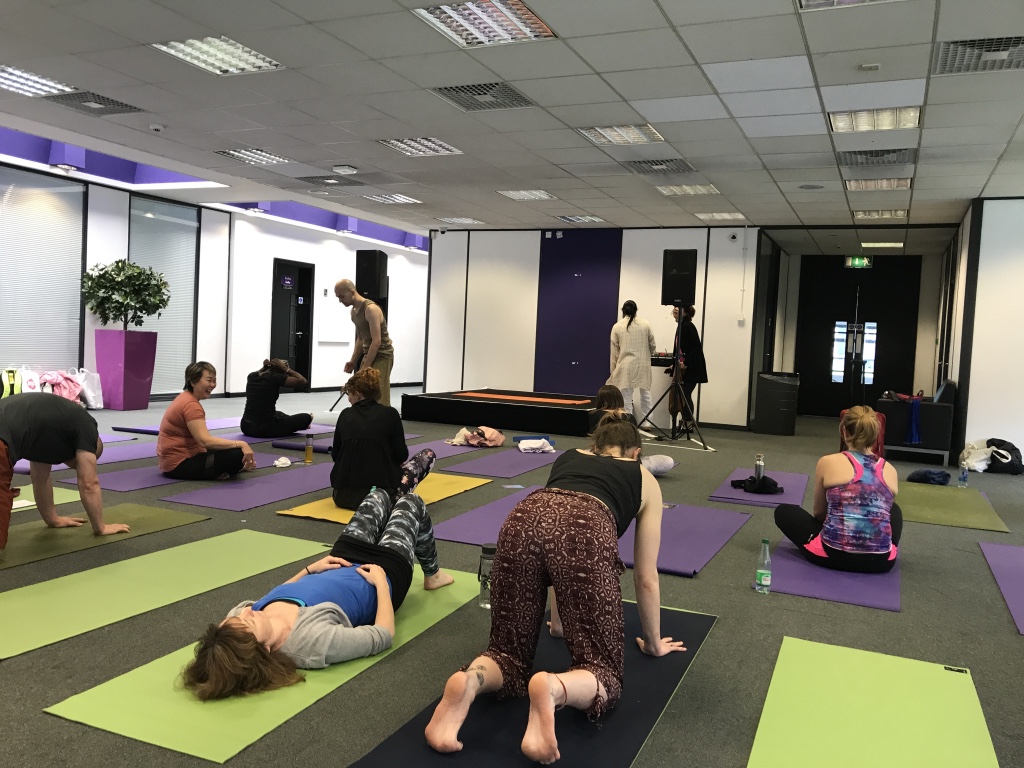
The workshop was billed as a Himalayan Hatha Yoga series with energy to create freedom and lightness in the body. There were intense sun salutations with upward dog kept on the toes rather than the tops of the feet. Looking around, I could tell that everyone found this a change from their ‘norm’. There were people of all abilities in the class which is always great to see and be part of.
We were put through our paces using fast flows, arm balances, strength postures and some of the most intensive Kriya and pranayama I have ever experienced. The breath holds and transitions worked to cleanse the body, generate heat and still the mind. It was very tough! We worked through standing postures testing balance and strength. We added in fast arm movements to challenge concentration and work alongside pranayama. There were opportunities to try transitions from headstand to side crow and back and chair to flying pigeon to name a few. There were also challenging bound postures which I enjoy but really test the limits of patience and surrender. This was a full body and mind workout. We sweated…a lot.
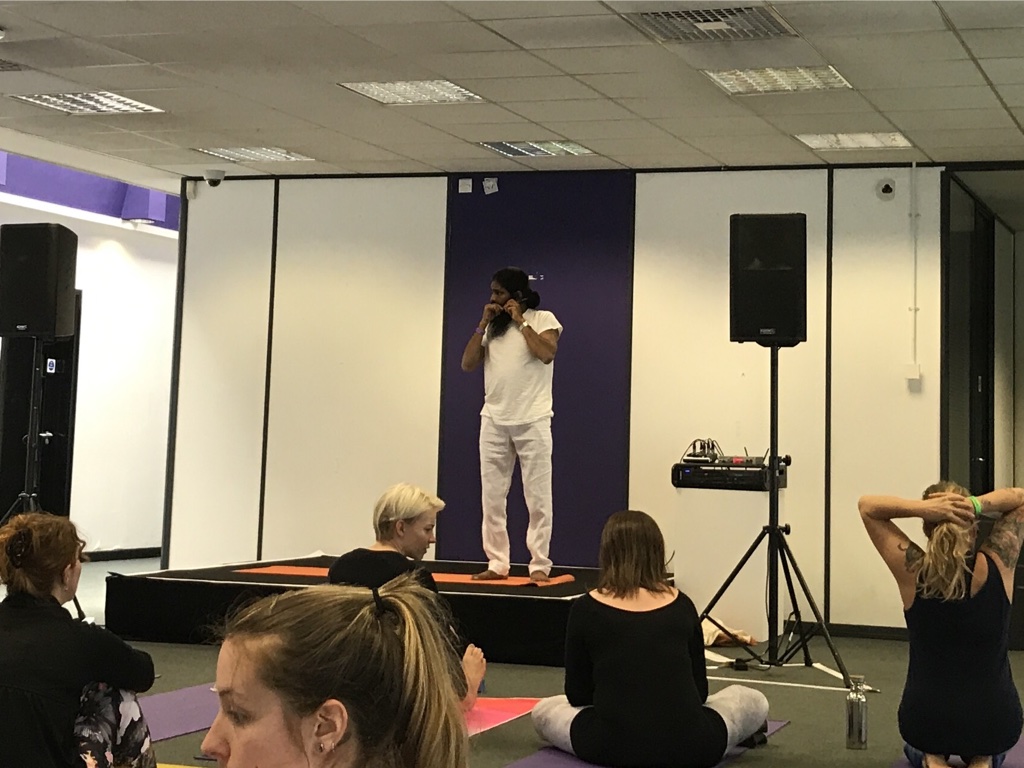
Yogi Ashokananda was encouraging and warm. Although he moved through transitions quickly he was clear in his instruction – although firm when he spotted we were flagging. He added in asanas and movements I haven’t tried or heard of before (wagtail or cheetah pose anyone?) but they were intense. I really enjoy this physical form of yoga because pushing the limits of the body helps to control the mind. I really found this a transformational session and have since used some of Yogi Ashokananda’s practices in my classes, particularly how to move within postures rather than just the traditional holds. I also really enjoyed using pranayama and kriyas as an integrated practice while doing asanas rather than sitting down and doing them separately.
The only let down for me was the poor quality of yoga mats that were provided. They were slippy to the point of being dangerous in a class such as this where sweat was an inevitability. Holding downward dog was a feat of concentration and resolve. I recommend taking your own mat to the Om Yoga Show if you intend to do a workshop.
We finished with some chanting aloud (again not very British) which everyone engaged with (surprisingly). I’m not familiar with the verse we chanted but many were so it was great to be a part of it. I always enjoy some Om chanting at the end of a class though, it just really fills me with happiness.
Yogi Ashokananda prepared us well for the class by saying “corpse pose is called corpse pose for a reason. You shouldn’t do it unless you feel like you’re going to die. Five straight hours of yoga will make you feel like you’re going to die…you only get to do savasana then”. He stuck to his word…there was no savasana after the most intense 90 minutes of yoga I’ve ever done. But, he was right. I didn’t need it and I didn’t miss it.
Namaste
OM Yoga Show 2017 – Manchester show review 19-21 May
This was my sixth visit to the Om Yoga show and the second time I’d been to it in Manchester. At £7.50 entrance fee this is a true bargain. After a succession of London venues that seem to be impossibly difficult (and time consuming) to get to, I thought the chance to drive ‘up north’ would be welcome.
The new venue at Event City was an excellent choice! Loads of free parking right outside the door. It was easy to get to and refreshingly didn’t involve multiple bus/train journeys and lots of waiting around – something that can’t be avoided in getting to the London venues of Alexandra Palace and Olympia.

Goody bags were freely available – no scrum necessary – just inside the door. We were able to help ourselves to show guides and freebies (powdered, vegan supplements for smoothies). The venue was large with lots going on this year. I always feel like the Manchester show might be the poor relation of the London event, but not true this year.
The bonus is that as it’s not as busy as the London show, you can actually get the chance to get into the open classes without a 30 minute queue and this year was the first time I’d managed to book onto my first choice workshop.
The best thing about the Om Yoga show is that it’s a hive of thriving young British businesses – loads of innovation and creativity in clothing, food, drink, styles of yoga and equipment that are freely available to us British yogis.
There was a strong display of exhibitors from therapists, food producers, tea importers, meditation aids, equipment, books, clothing, accessories and interiors. Really everything you’d want to see at this kind of show and far more. The Manchester show is definitely not a runner-up to London any more.
There were 3 open class studios, a children’s yoga studio and a meditation area this year. Classes ranging from gentle introductions, innovative new styles, traditional asanas, challenging backbends and arm balances and focus on all 8 limbs of yoga with some Ayurveda and holistic therapy thrown in. There were 93 free classes to choose from this year so it’s not just a day of shopping and browsing – there are multiple good quality activities to fill the day as well. With about 15 workshops per day ranging from £5 to £10 there were also some world class teachers to choose from for a more in-depth experience. I booked onto a masterclass with Yogi Ashokananda for £10 – the best yoga class I have ever been to! My workshop review can be found here.
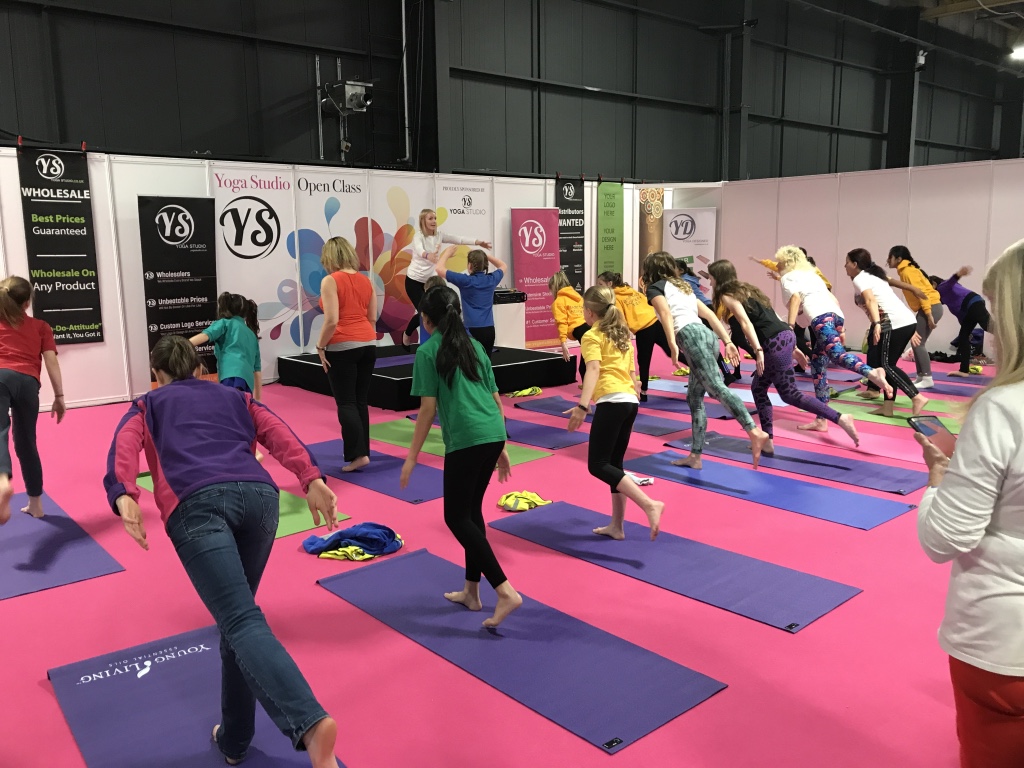
The hot yoga pod was absent this year, but had been replaced by an aerial yoga workshop space. I like that the Om Yoga show encourages attendees to get stuck into new incarnations of yoga as well as sticking to the traditional. Whatever your viewpoint on yoga, there will be something for you to enjoy here.
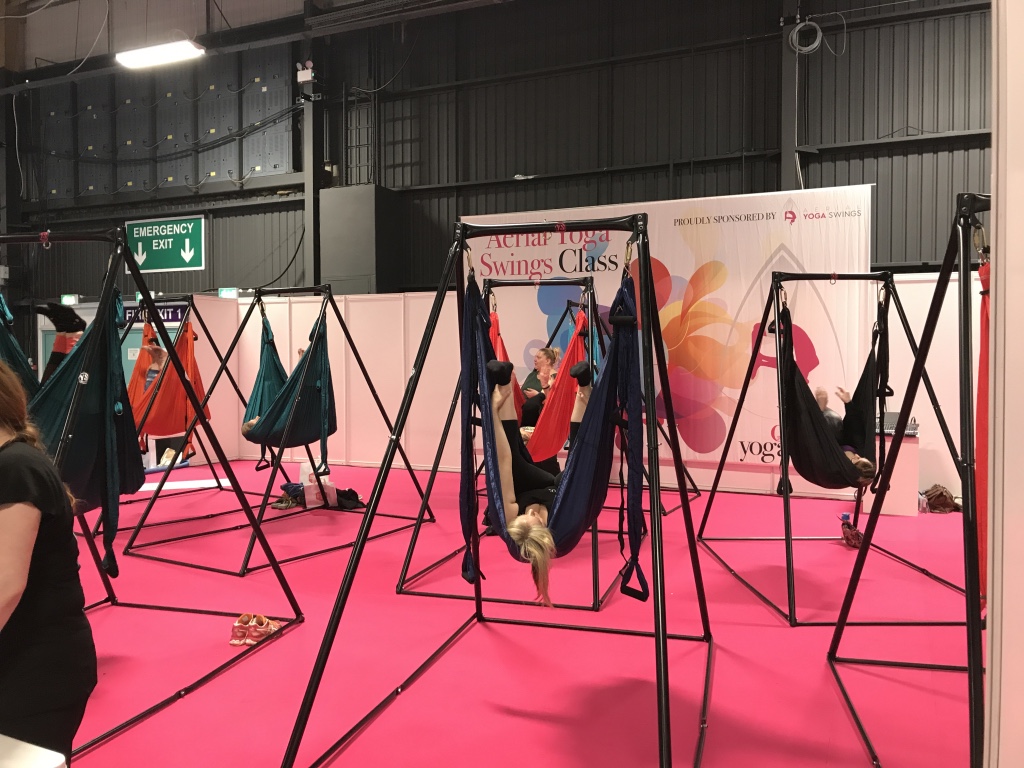
No review would be complete without a mention of the vegan food court – AMAZING! This year was the best selection of food I’ve ever seen at the show. So many local home kitchens and creative vegan cooks. It was hard to choose, but a special mention needs to go to Home Kitchen Vegan who produced the most fantastic vegan curry.
Special mention to my favourite exhibitors this year:
Yoga clothing to die for The Power of Greyskull
Yoga bliss from a world class teacher Yogi Ashokananda
I dare you to leave without trying one of these drinks by Big Juice
The Om Yoga Show will be back in London 20 – 22nd October 2017

